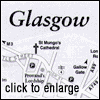|
Around Glasgow
Pollock Country Park
Continuing south-west along the B769 or route signposted
to Kilmarnock on the A77, the Burrell Collection is set in the spacious grounds of
Pollock Country Park to the right and is free. Opened in 1983 there are many who
reckon it was as much an instrument in Glasgow's change of fortune as the 'Glasgow's
Miles Better' campaign. The timing of its appearance on Glasgow's cultural scene
certainly could not have been better for putting the city into the minds of the art,
media and business worlds.
Sir William Burrell was a wealthy Glasgow shipping
magnate who, using the fortune amassed from the astute timing of the sale of his
fleet, spent his life travelling the world in search of works of art and antiquities
that he liked.
The Burrell is now one of the most popular galleries
in Britain. Chinese ceramics, Persian carpets, medieval European furniture and stained
glass along with modern painting and sculpture make it one of the most diverse collections
of artefacts found anywhere in the world. Ancient Mesopotamia and Egypt are also
well represented.
Pollock House is in the same grounds as the Burrell,
built in 1750 and housing one of the finest collections of Spanish paintings in this
country. There are woodland areas and a pleasant river in front of the house.
Paisley
There are several areas quite close to Glasgow that
make ideal day trips from the 'Empire's Second City'. The M8 swoops over the kingston
Bridge towards Glasgow Airport past the communities of Paisley and Renfrew. Paisley
has several historic connections, not least of which is the creation of a fashion
for fantastic patterned shirts that were the rage around the world in the late 1960s.
Paisley's town centre is graced with several imposing
buildings set amongst the more typical lowland town merchandisers. For contrast to
the rather oppressive exterior of Paisley Abbey, traverse through the High Street
to find the Thomas Coates Memorial Church, a more opulent example of Victorian design.
The banks of the Clyde
 The M8 splits at Erskine Bridge leading to Dumbarton and Helensburgh
while the west route follows the Clyde. Port Glasgow was a small fishing village
until the late seventeenth century when it was purchased by the town of Glasgow to
become the city's main port. The M8 splits at Erskine Bridge leading to Dumbarton and Helensburgh
while the west route follows the Clyde. Port Glasgow was a small fishing village
until the late seventeenth century when it was purchased by the town of Glasgow to
become the city's main port.
Newark Castle overlooking the Clyde, stands out amidst
the flotsam of the docks. This turreted fifteenth century construction is in remarkably
good condition for its 400 years, once a tower house for the Maxwell family and now
open to visitors.
Further on is Greenock, another beneficiary of the
Clyde's industrial hey-day. Looking over the water, Inverclyde's Waterfront, a new
development, offers a wide range of activities including a leisure ice rink and a
curling rink. There is also alongside a cinema and Waterfront Retail Park.
In Cathcart Square, the main focus is the 245ft (75m)
Victorian Tower, which now houses the Tourist Information Office. In Union Street
is the McLean Museum and Art Gallery which contains some of the work of James Watt,
the celebrated eighteenth century industrialist and developer of the steam engine,
who was born in Greenock.
Gourock, just down the coast, is an old seaside resort
with some character especially along its esplanade with its marvellous views over
the Clyde to the Cowal Peninsula. Gourock Golf Club sits high above the town and
enjoys splendid views from its high tees.
The A82 travels the north banks of the Clyde, a dual
carriageway leading to Dumbarton, Alexandria and Loch Lomond. Dumbarton is a rather
ugly development of the 1960s and 70s, despite it having a castle that can trace
its origins back to Roman times. To reach it, take Victoria Street from the town.
Its situation is ideal, surrounded on the three sides by water with views up and
down the Clyde.
The Isle of Bute
From Glasgow, the route is along the south bank of
the Clyde. The ferry to Dunoon sails from Gourock, taking only a few minutes to cross
the Clyde to reach this popular holiday resort. The Tourist Office is on Alexander
Parade, which is also useful for locating accommodation.
Behind the town, the Cowall Peninsula is formed by
Loch Fynne and Loch Long and offers a variety of landscapes from the peaks of Argyll
Forest Park in the north, to the more temperate environs of the south-west.
The Isle of Bute stands below the Cowall Peninsula.
Its main attraction is the seaside town of Rothesay which, like Dunoon, has attracted
Scots holiday-makers for decades. There are moves to bring it into the late 90s and
make use of its Winter Gardens, the Promenade, the pier and the many guest houses.
Rothesay Castle sits above the bay.
There is a small display of the area's heritage at
Bute Museum in Stewart Street. The island of Bute is popular with retirees and those
keen on growing a garden that reaps the benefits of the Gulf Stream. The A844 follows
a figure-of-eight tour of the island that finishes back at the short ferry crossing
onto Cowal or you can catch the frequent ferries back to Wemyss Bay where the mainland
ferry terminal is sited. From Wemyss Bay the A78 carries on south into Ayrshire or
back into Glasgow.
North of Glasgow
 Residential areas immediately ring the area north of Glasgow,
then open agricultural land before coming to an outer ring of towns. These are closely
associated with the city but just out of reach of the urban sprawl and so are more
countrified than metropolitan. Residential areas immediately ring the area north of Glasgow,
then open agricultural land before coming to an outer ring of towns. These are closely
associated with the city but just out of reach of the urban sprawl and so are more
countrified than metropolitan.
From the north east of Glasgow, these start with Coatbridge
which now has a tourist centre recently grafted in with a rather remarkable ice-rink
and swimming centre called the Time Capsule. Here you can swim through the River
of Life or Skate through Time. Erupting volcanoes, rocket launches and water spraying
serpents accompany you. Coatbridge was a key element in the Scottish industrial scene,
providing much of the steel for the thousands of ships that were built on the Clyde
as well as for the Forth Bridge.
Travelling westwards are Kirkintilloch and Bishopbriggs
with the Campsie Fells, a long string of medium-sized hills protecting this area
from the north. The Stables pub and restaurant sits on the banks of the canal between
Bishopbriggs and Kirkintilloch and is quite entertaining to sit out in good weather.
Kirkintilloch is another town that has been treated
badly by modern planners. There are some lovely terraced cottages at the west end
of the High Street, but from there on there is a gradual deterioration until tasteless
video stores and off-licence outlets prevail.
Further west is the Glasgow suburb of Bearsden and
nearby Milngavie, pronounced 'Mulguy'. The main route north from here is the A809
passing through the Kilpatrich Hills with the Campsie Fells to the east. Drymen is
the next village and acts as a gateway to the Trossachs area.
South of Glasgow
The south-eastern side of Glasgow is another region
worth exploring especially by car. Basically, the area surrounds the Clyde Valley
following the river to its source. The A724 passes through Rutherglen and then joins
the A72. Bothwell Castle is worth detouring for, once one of the finest red-sandstone
castles in this part of the land. It stands high above a loop in the Clyde, a mighty
stronghold that endured during the English attacks in the early fourteenth century.
The nearby village of Blantyre was the birthplace of the explorer and missionary,
David Livingstone, in 1813.
Following the River Clyde towards its origin, the
environs of Glasgow and the marks of its indutrial endeavours are finally left behind
revealing aN area of deep valleys and gentle agricultural rises. This region is sometimes
referred to as the 'Greenhouse Glen' with quaint little cottages looking over their
attenuated gardens.
Lanark
Lanark is an old market town with the world's oldest
bell cast in 1130, but otherwise the town is rather bleak. The double-laned main
street now choked with traffic, is overlooked by a statue of William Wallace who
lived in Lanark for a time. Lanark Golf Club is frequently commended for its challenging
heathland course and comfortable clubhouse.
Following Braxfield Road from the town of Lanark,
you approach the village of New Lanark only 1 mile (2km) from the centre of the old
town. The view looking down into the valley is quite stunning. With misty sprays
rising above the village, this was one of the first communities to bring together
industrialism and social development.
New Lanark was founded in 1785 by rich industrialist
David Dale and his partner Richard Arkwright, with the purpose of yoking the power
of the Falls of Clyde for their cotton mills.
It was Dale's son-in-law, Robert Owen who had the
vision to create a model community when he became manager of the estate. He called
his experiment the 'village of unity' and in 1798, he created the country's first
infant school and adult education facility. The 'Annie McLeod Experience' is a tour
through the social history of life in the village as seen through the eyes of a mill
girl of the era.
The path skirting the river leads to the Falls of
Clyde Nature Reserve with spectacular falls plunging 90ft (27m) in three stages.
En-route is Wallace's Tower or Corra Castle perched on a pinnacle above Corra Linn.
Biggar
The most south-easternly town in the Clyde Valley
is Biggar, 13 miles (21km) on from Lanark on the A72 and a main stopping point on
the A702 from Edinburgh to the south-west. The River Clyde flows nearby, a much junior
version of the waterway some 50 miles (80km) north-west.
Biggar has no less than four museums. The Moat Park
Heritage Centre just off the High Street in a converted church is exceptionally well
put together and gives a listing of the Upper Clyde and Tweed Valleys along with
a fascinating display of table covers and other embroidery.
The Gladstone Court Street Museum on North Bavk Road
is a re-creation of a Victorian street complete with cobblers, dressmakers, a chemist
and even an early telephone exchange. On Burns Braes is the Greenhill Convenanters
House which helps explain this confusing period in Scottish history.
Near the War Memorial is the Biggar Gasworks, built
in 1839 and closed in 1973, an unusual museum that might stir memories for those
that remember gas mantles and the smell of coal gas works of which this is the sole
surviving example.
|


